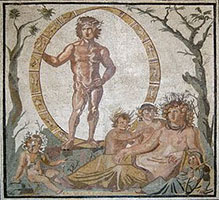 The Greek word aiṓn came to Latin as aeon , which in our language became eon . The term has various uses depending on the context.
The Greek word aiṓn came to Latin as aeon , which in our language became eon . The term has various uses depending on the context.
In colloquial language , an aeon is a very long, although imprecise, period of time . For example: “I haven't eaten this dish in eons,” “I feel like eons have passed since I last spoke to Marta,” “It seemed like I was locked up for eons, but in reality the captivity didn't last more than two hours.”
For geology , an eon is a unit of time that is equivalent to 1 billion years . The time interval that allows the history of planet Earth to be divided into three stages is also called an eon: the archaic eon , the proterozoic eon and the Phanerozoic eon .
The archaic eon began about 4 billion years ago and lasted until 2.5 billion years ago. In that instance, the Proterozoic eon began, valid until 542 million years ago. From then until today, the Phanerozoic eon develops.
In the field of Gnosticism (a religious and philosophical doctrine that combines Christian, Eastern and Judaic elements), each divine and eternal entity that has its origin in the supreme divinity is called aeon. The aeons, in this framework, are beings that relate spirit and matter.
Greek mythology , for its part, calls Aeon the god of prosperity and eternal time. He is usually depicted as a scantily clad or naked young man standing within a zodiacal circle.
The god Aeon is impartial and supreme, he has no beginning or end. He differs from Cronus, another god of Greek mythology who personifies time itself, precisely in that he does not represent it as something limited or that can be contained, but as something empirical that encompasses all eternity. It is related to mystery religions , those that seek to transmit wisdom through experience.
Eon has in common with this group of religions themes and concerns such as life after death and the mysteries of Cybele, Mithraism, Orphism and the Dionysian mysteries. He is usually accompanied by earth goddesses such as Cybele or Tellus, or also mother goddesses. This can be seen in the Pátera of Parabiago .
 A pátera is a dish that was used for certain rites and ceremonies of a religious nature in Antiquity. One of its most obvious characteristics is its shallow depth. That of Parabiago, an Italian town located in the province of Milan, is made of silver and was made in the 4th century by Roman goldsmiths during the reign of Flavius Claudius Julian. In his engravings you can see a representation of several mythological characters, such as Cybele, Attis, Corybantes, Tellus and Aeon himself.
A pátera is a dish that was used for certain rites and ceremonies of a religious nature in Antiquity. One of its most obvious characteristics is its shallow depth. That of Parabiago, an Italian town located in the province of Milan, is made of silver and was made in the 4th century by Roman goldsmiths during the reign of Flavius Claudius Julian. In his engravings you can see a representation of several mythological characters, such as Cybele, Attis, Corybantes, Tellus and Aeon himself.
In Latin, this god may appear in relation to the concepts of Aevum and Saeculum . The first, according to scholastic philosophy, represents the mode of existence that angels and saints experience in paradise: in some way, it is a state that is between eternity and temporality. The second is a term that refers to a period of time comparable to the life of a human being or what is needed to completely renew the population of our species.
The zodiacal circle within which Aeon is usually represented can be understood in various ways, such as eternal or cyclical time. In addition to the Parabiago patera, this image can be seen in the Roman mosaics of Sentinum (current Sassoferrato) and Hippo Regius.
E.ON , finally, is a German company in the energy industry. It is one of the main European public service companies.
